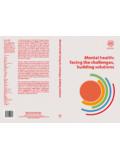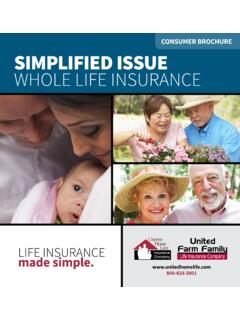Transcription of EMERGENCY LIGHTING AND CONTROL - Lighting and …
1 I. OverviewEmergency LIGHTING CONTROL options arerapidly expanding in response to growingneeds by design professionals and buildingowners to save energy and achieve aestheticand functional design objectives. Yetemergency LIGHTING part of a building s lifesafety system remains highly regulated,making system design and product selectiona challenging and often confusing task. Theintroduction of next generation automaticload CONTROL relays designed and listed foruse on EMERGENCY LIGHTING circuits warrantsthe attention of designers and ownersbecause of the significant performancebenefits offered by these innovative, code-compliant paper provides background on themany codes governing EMERGENCY LIGHTING . Itexplains why specifiers in some regions arehaving to allocate more watts per squarefoot to EMERGENCY LIGHTING than they have inthe past, making the energy waste of always-on LIGHTING designs a significant operatingexpense.
2 The paper also discusses a varietyof EMERGENCY LIGHTING and CONTROL options,and the benefits of each, and offers thereader important criteria to consider whenevaluating EMERGENCY LIGHTING Background on EMERGENCY lightingrequirementsEmergency LIGHTING is required in allpublic buildings to facilitate egress andprotect life safety. In general, emergencylighting is required to come on automaticallywithin ten seconds after a loss of power andmust operate for a minimum of 90 minutes(although designers should consider the sizeand nature of the building to ensure that thistime frame is adequate for orderlyevacuation). EMERGENCY lightingrequirements include extensive regulationsfor exit signage, but this article onlyaddresses the associated amount and quality of emergencylighting, in addition to the wiringrequirements for EMERGENCY circuits, arespelled out by a wide variety of local andnational codes, some of which includeconflicting information.
3 Exceptions in codes,and specific requirements for different usesand occupancies, further complicateinterpreting the codes. A recent trend insome state and local code updates, includingthose of large metropolitan areas such asLos Angeles and San Francisco, is to changethe word average to minimum in relationto the level of illumination (in most cases,one footcandle) required for , some national codes still onlyrequire an average level of final interpretation of the codes is leftto the AHJ (authority having jurisdiction), andsince approved EMERGENCY LIGHTING must beEMERGENCY LIGHTING AND CONTROLWatt Stopper/Legrand2800 De La Cruz Blvd / Santa Clara, CA 95050 (408) 988-5331 / (408) 988-5373 Fax(800) 879-8585 Tech Support/Plano, place for a building to receive a certificateof occupancy, designers may be advised toplan for the more stringent national codes and standardsgoverning aspects of EMERGENCY lightinginclude publications of the National FireProtection Association (NFPA), UnderwritersLaboratories (UL) and the Uniform BuildingCode (UBC), among others.
4 See the sidebar for references to specificcodes and standards covering emergencylighting EMERGENCY LIGHTING and controlsolutionsWiring for EMERGENCY circuits must bekept separate from normal wiring to preventfaults from affecting the operation ofemergency systems, and only lightingdesignated as EMERGENCY may be includedon an EMERGENCY circuit. Because of theserequirements, several basic solutions toemergency LIGHTING have become standardpractice, but these solutions includeaesthetic and operational equipment, or battery pack LIGHTING ,is perhaps the most straightforward solutionas power and LIGHTING are , this equipment must be provided inaddition to a complete general illuminationscheme as the Life Safety Code states thatsuch lights cannot provide the principallighting of an area.
5 In addition, the unitsstand out visually, detracting from the designof an otherwise pleasing space. Unitinverters battery packs, typically installedReviewing the RegulationsNFPA 101 The National Fire Protection Agency s LifeSafety Code (NFPA 101) specifies illuminationrequirements for particular areas in buildingswith different occupancies that must beimmediately available to facilitate egress inthe event of an EMERGENCY . Theserequirements are discussed in Article Illumination of Means of Egress, Article EMERGENCY LIGHTING , and articles dealingwith specific occupancies. While egresslighting and EMERGENCY LIGHTING do haveseparate definitions, one set of LIGHTING istypically used to meet the requirements ofboth definitions. NEC NFPA 70, the National Electrical Code,defines what kinds of equipment may beused, and the installation and maintenancepractices that must be followed, to meet theillumination requirements of the Life SafetyCode.
6 The NEC discusses EmergencySystems in Article 700, and defines them as those systems legally required and classedas EMERGENCY by municipal, state, federal, orother codes, or by any governmental agencyhaving jurisdiction. These systems areintended to automatically supply illumination,power, or both, to designated areas andequipment in the event of failure of thenormal supply or in the event of accident toelements of a system intended to supply,distribute, and CONTROL power and illuminationessential for safety to human life. The NEC also defines Legally RequiredStandby Systems (Article 701) and OptionalStandby Systems (Article 702), which areoften confused with EMERGENCY Systems,since all are designed for use in the event ofpower failures, emergencies, naturaldisasters, fire, terrorist attack, etc.
7 To clarify, EMERGENCY Systems are those essential forsafety to life, Legally Required Standby Watt Stopper/Legrand2800 De La Cruz Blvd / Santa Clara, CA 95050 (408) 988-5331 / (408) 988-5373 Fax(800) 879-8585 Tech Support/Plano, LIGHTINGAND CONTROL2in fluorescent fixtures offer a moreaesthetic solution, but require a central auxiliary power system will beavailable, many engineers prefer to lay out ageneral LIGHTING design that is fed from twosources. Most of the LIGHTING is fed fromnormal electrical panels, while selectedfixtures those located to provide therequired levels of egress LIGHTING are fed byseparate EMERGENCY circuits. To addresscode sections that require egress LIGHTING tobe on when the space is occupied and thatlimit switching options on emergencycircuits, the EMERGENCY LIGHTING is usuallydesigned to be always-on, burning 24 hoursa day.
8 The obvious drawbacks to thisapproach are wasted power and theinflexibility of CONTROL , especially in spacesrequiring LIGHTING to be switched off ordimmed for presentations or other optionsFor facilities with complex lightingcontrol requirements such as theaters, all ofthe LIGHTING may be powered from a normallighting panel and controlled as a singlesystem during normal building operation. Tomeet code requirements, selected branchcircuits must be automatically switched to anemergency power source during the loss ofnormal power. UL 1008-listed emergencytransfer equipment installed on the circuitsdesignated as normal/ EMERGENCY willappropriately switch them between powersources. This transfer function, whichSystems are extra systems required for specific types of buildings to provide power toaid in fire fighting, rescue operations, controlof health hazards, etc.
9 , and Optional StandbySystems are those intended to minimize thedisruption to business caused by powerfailures. The equipment and installationrequirements vary for each type of system,but NEC Article permits a singlealternate power source to provide power forall three systems. However, since prioritymust be given to power EMERGENCY Systems,separate wiring and equipment is used foreach system so that loads can be picked upand shed in the correct order. Testing requirementsBoth NFPA 101 and the NEC require periodicfunctional testing of EMERGENCY lightingequipment. building codes building codes including the UBC and the IBCas well as state and local codes also defineemergency LIGHTING levels and uniformityrequirements, installation parameters andtesting and recordkeeping requirements.
10 ULUnderwriters Laboratories tests and approvesthe components of EMERGENCY systems to besafe for a specific use. Two distinct listingcategories apply to EMERGENCY LIGHTING andpower CONTROL equipment: UL 1008 and UL924. UL 1008, Automatic Transfer Switchesfor Use in EMERGENCY Systems, applies to theswitching gear that transfers the power feedfor the EMERGENCY circuits from the normalsource to the EMERGENCY source and back. UL924, Standard for Safety for EmergencyLighting and Power Equipment, applies tomost of the components downstream of thetransfer switch. All components of anemergency circuit must be appropriatelydesigned and switching both the hot and neutralconductors, is complex. Transfer switchesmust be designed to withstand available faultcurrents and provide specific switchingdelays to prevent the normal and emergencypower sources from being transfer equipment is expensive for useon branch option for some locations is toinstall separate normal and emergencylighting circuits with parallel controls oneach.







